How Does My Radio Work?
How is it that you can listen to signals on your radio? We delve into the science of radio. From how one is made, to listening out for alien broadcasts. Plus in the news, we look at the potential for the third wave of Covid, how the vaccine fairs in pregnant people, and some muons behaving badly?
In this episode

00:55 - Will the UK have a 3rd wave of COVID?
Will the UK have a 3rd wave of COVID?
Tim Spector, King's College London
In the UK, Covid-19 cases are now very low, helping to unlock the next step on our lockdown-easing roadmap; many of the adult population celebrated the return of former freedoms at newly-reopened pubs, raising a glass in the process to the fact that 32 million people, more than half the population, have so received a dose of vaccine: one of the highest rates in the world. Meanwhile, cases continue to surge across Europe, and in South America and India, in what many are calling "the third wave". Since early in the pandemic, Kings College London's Tim Spector has been following the course of the outbreak and monitoring its trajectory with the Covid ZOE app he helped to develop and which has generated large amounts of data and insights into the activity of the new coronavirus around the country. So does he think we're in for a third wave as we open up?
Tim - No, not this summer and probably not this year. I think we might have a ripple at the end of the year, as the immunity wanes and we get cold weather again, but I'm not seeing what we would now consider a third wave, in my estimation.
Chris - Why are you at odds with what a lot of people - a lot of eminent people - have been saying is the likely outcome from our present situation? And also with an eye on what's going on in Europe - of course they're experiencing what they're dubbing the 'third wave'.
Tim - Well, the 'third wavers' have been relying on modelling, which is always based on a number of assumptions. The data we're seeing from the ZOE app is much more reassuring than a lot of those assumptions, in terms of: the efficacy of the vaccine, in certainly preventing cases, is much higher than was predicted in a lot of those models. And so that's the reason, I think, we have got our case levels so low; this week they're down below 2000 cases a day where we were back in July last year. It's that detail about the vaccine, that we're seeing... even after one shot we're getting 50% less cases, and after two shots we're getting 15 times less cases. That's the thing that heartens me, that we are progressively moving towards herd immunity. That's why I don't think variants - whether they come from abroad or inside - are going to be able to take hold this year.
Chris - Last week, University College London put out a paper suggesting we were about to cross that magic threshold, that had been proposed as a target to achieve some semblance of herd immunity: in other words, the number of people as a proportion of the population that are immune. Do we actually know, though, what fraction of the population need to be immune to stop this thing spreading?
Tim - Estimates seem to be somewhere between 50-75%. So the fact we're at 60% vaccinations, and there's probably another 10% of people that have got antibodies, suggests that we're pretty close to that.
Chris - I wonder why the Prime Minister earlier this week, then, was at pains to say: this is the effect of the lockdown - don't read too much into the vaccines yet. Is that just really to stop people going off on a bender because the pubs are open again?
Tim - His comment doesn't really make sense to me, looking at the data, because when lockdown came, we'd already seen the peak in most of the country. I believe that the lockdowns have helped - social distancing and reducing mobility absolutely helps - but there's no doubt that the vaccine has been really much more effective than people thought it would be in real life. And we've got a paper coming out in a week or so to show that. It's broken the cycle of infections in hospitals, and in care homes, that plagued this last year. I think it's made a real difference this time. And so outbreaks really can't gain hold because there just aren't enough susceptible people.
Chris - What about the issue of variants though? Because we saw the dramatic impact of the appearance of the Kent variant, when it first popped up on our radar screens back in September, and then eclipsed everything in the country by Christmas. What about the possibility of a new variant coming in - either from one of the other countries being ravaged by coronavirus at the moment, or just popping up spontaneously within the circulating viruses we already have in the country?
Tim - Well, I think we definitely will see new variants. I think everyone's agreed on that. The question is: is that variant going to be dominant enough over the other strains to take over? And if it has fought off the other strains, does it have the ability to fight off previous immunity or the vaccines? Really, there's no hard data to say that any of these strains do anything more than slightly reduce the efficacy of the current vaccine. So given there are so many 'ifs', there's no reason that we should stop all our plans to come out of lockdown, because I think they're getting increasingly remote.
Chris - Is that true though? Because if one looks at Brazil, as one example, people are suggesting that if you look at, say, the P1 variant that popped up in Manaus: in that part of the country last year, the number of people hit by coronavirus initially was at least 70-80% of the population. That same area is being hit again by this new variant, which appears to be bypassing the immunity those people naturally had, having been infected previously. So does this not argue that actually, if a new variant - including the Brazil variant - pops up here, we are potentially in trouble and back to square one?
Tim - If that is entirely true, then I think there would be cause for concern. But I think whether that is the actual case, and whether the data in Brazil about what happened previously is really good enough, I'm not so sure. The likelihood that a new strain would come in and take over a complete, currently-immune or previously exposed population to such an extent that it caused a major third wave, I just see as still very unlikely.
Chris - Is it not a serious concern though, that if we do send our population off on holidays to countries where there's a partially vaccinated population, this is the ideal breeding ground for the kinds of mutants that could infect vaccinated people, so therefore the only coronavirus people are going to come back with is one that can bypass immunity from the vaccinations, and then we'll spawn new outbreaks here?
Tim - I think that's a possibility, but it's a question of weighing up the bigger picture - the economic picture, and the psychological picture - of whether we want to lock down as an island for several years like New Zealand. That's the alternative. One of the key questions here is: do fully vaccinated people really transmit the virus in enough numbers to be a worry and bring it back? And I think that's the killer question. And depending on that, then vaccinated people are more or less free to travel as they want.
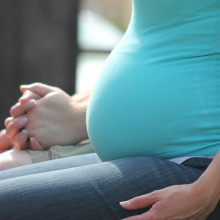
08:43 - COVID vaccine effective in pregnant women
COVID vaccine effective in pregnant women
Andrea Edlow, Massachusetts General Hospital, Harvard Medical School
And with another encouraging step forward, the UK’s Joint Committee on Vaccination and Immunisation, the JCVI, has now advised that pregnant women should be offered the COVID-19 vaccine at the same time as the rest of the population, based on their age and clinical risk group. This is a change from the previous guidance that pregnant women should only be vaccinated if their risk from COVID-19 was judged to be high. This initial stance was adopted not because there’s any evidence of danger, but because it’s standard practice not to test new drugs on pregnant women, so there was initially no data on whether the vaccine is safe or effective during pregnancy. Now real-world data from the US is giving reassuring results. Phil Sansom heard about one study, published in the American Journal of Obstetrics and Gynaecology, from Harvard’s Andrea Edlow who’s been measuring antibody levels in 131 vaccinated pregnant women...
Andrea - The levels of those antibodies were equally high in pregnant and lactating women as they were in women of reproductive age who were not pregnant.
Phil - I mean, fantastic! Sounds like good news!
Andrea - It was great news for pregnant and lactating women everywhere.
Phil - Was that not what you were expecting?
Andrea - It's a reasonable question to investigate, because we know that pregnancy is a situation where women are relatively immune tolerant. And that's partly in order to tolerate the developing foetus, which is half-not-the-woman herself.
Phil - Okay. So with these 130 participants, can you be reasonably sure of saying, "yes, these mRNA vaccines work just as well for these people?"
Andrea - Yes. I think we can be reasonably sure at looking at what's called the efficacy of the vaccine, or how well the vaccine functions to give people antibodies.
Phil - What about for the baby? What are the implications?
Andrea - We looked at the women in our study who delivered during the study period, and that was only 10 of the pregnant women. And we found that antibodies were present in the umbilical cord blood of all ten babies - and in the mother's breastmilk.
Phil - So does that mean the babies were actually coronavirus resistant?
Andrea - That is something that our study couldn't specifically look at, because we didn't - of course - go on to try to expose the babies to coronavirus and see if they were resistant to it. But yes, we assume that the presence of antibodies in the umbilical cord will give babies some degree of protection. But how much is needed to give more complete protection, and how long that protection will last in babies, is something that isn't yet known, and our study couldn't answer unfortunately,
Phil - There's obviously a million concerns going around about the vaccine. And one other one that I've actually heard from some people is, they say, "is at a risk if I'm trying to get pregnant?"
Andrea - That's a very good question. And that's a common question that we get a lot as obstetricians. There was some sort of, what - for lack of a better word - I could just honestly call junk science, that was perpetuated early on in the evolution of the vaccines; where people were saying that the mRNA sequence in the vaccine, so the code that the vaccines have that tells your immune system to make these proteins, had some similarity to the code that might be in the placenta. That has been disproven. There actually is extremely little overlap in the mRNA sequence, or code, that's in the virus, with any mRNA that's in the placenta. So that basically was just completely false.
Phil - Now that you've done this study, would you feel confident saying this vaccine is safe for pregnant people, or safe for people who've just given birth, or what?
Andrea - Our study did not specifically look at safety. Our study was designed to look at efficacy, which is: how well does it work to give you antibodies? There are studies that look at safety that are ongoing; Pfizer's doing a trial with over 4,000 pregnant women. But you really need a very large segment of the population to see a safety signal. So our study doesn't look at safety, and the data that do look at safety are still evolving,
Phil - Right, so if I were pregnant, and I were getting offered an mRNA vaccine, what would you tell me?
Andrea - I would tell you that you, together with your trusted care provider - whether that's your obstetrician, a midwife - should look at your risk of getting COVID, your own medical conditions; and then to think about the known risks of having COVID-19 in pregnancy. We know that women who do get COVID-19 in pregnancy are more likely to need a ventilator, more likely to need a heart-lung bypass machine, and unfortunately more likely to die, than women who are the same age who are not pregnant. So weighing all those risks, your own personal risks as well as the general risk of pregnancy, against the small risk of the unknown, where pregnant and lactating women were excluded from the original vaccine trials. So unfortunately we don't have the human safety data in pregnancy that we have in animals. But the animal safety data that the mRNA vaccines have doesn't show concerns. And I think this just highlights why women never should have been left out of these trials in the first place.
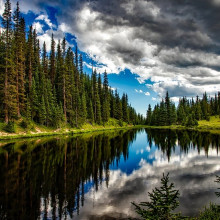
14:33 - Keeping endangered animals parasite free
Keeping endangered animals parasite free
Josh Brian, University of Cambridge
Trying to keep animals safe has a lot of pitfalls. Sometimes threatened animals are moved from one place to another, to keep them safe. And a new study from the University of Cambridge published in Conservation Letters, looking at fresh water mussels, has shown that it can be very easy to transport parasites and other pathogens, along with the animals you’re trying to protect. Josh Brian spoke to Adam Murphy about protecting these mussels...
Josh - Well, they get a whole range of things, and what we've found is that often we don't understand the full range that these mussels get, but some of the main ones are castrating worms. So these worms live inside the gonad of the mussel, castrate the mussel, and then use them basically as a factory to produce their own reproductive stages for the rest of the mussel's life. They also have mites which can eat the gills. And what we're seeing now, especially from the US, is that there's a lot of emerging evidence of viruses and bacteria which can spread through these muscles very, very quickly.
Adam - And why is protecting them so important?
Josh - Well, these freshwater mussels are hugely important in terms of ecosystems, so they were known as "ecosystem engineers''. So they modify the sediment, they help with nutrient cycling, and they're also massive filter feeders. So my favourite stat about freshwater mussels is that the entire volume of the river Cam that flows through Cambridge is filtered through freshwater mussels every two weeks. So they do a massive job of cleaning the water. In addition, because they form these massive mussel beds along the banks, they can help prevent erosion and things like that as well. But on the whole freshwater mussels are actually one of the most threatened animal groups in the whole world. So it's really important that we understand all the threats facing them and take appropriate steps to protect them.
Adam - Say an infected mussel got into an uninfected group, how much damage could that do?
Josh - Well, it could do a whole lot of damage, especially if it's something which can spread straight from mussel to mussel. You know, if the mussels in the recipient population maybe don't have the same immune response that the previous mussel that that was introduced to it does, this could spread very quickly from mussel to mussel, and do a whole lot of damage. However, sometimes it'll also depend on the life history strategy of the parasite. You know, some parasites need multiple hosts in their life cycle. And so if those hosts are present or not, that'll determine how much damage these parasites can do. So we really need to understand not only our mussel populations, but also really need to look more at parasites and their life histories.
Adam - And so I get why this is important for mussels and how important mussels are, but is this work applicable beyond them to other animals?
Josh - Absolutely. So the principles that we talk about in our paper, we think they're relatable to any sort of translocation that we see. What we really want to emphasise in our paper is that, you know, an individual organism isn't actually just one individual, it's a whole community. It's a community of all the bacteria, viruses, worms, ticks, mites, et cetera, that live on it and in it. And if we want to transport organisms appropriately, we really need to appreciate that they do comprise these whole communities, and this will be true for any single animal that's moved. So it's not just mussels that this could be a threat to, any animal could carry parasites or diseases if we move it around and introduce it to new organisms.
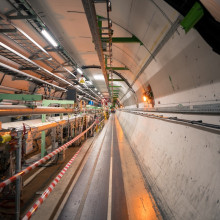
17:56 - Muons behaving badly
Muons behaving badly
Ben Allanach, University of Cambridge
Scientists have recently announced two independent discoveries that suggest we've got a gap in our understanding of the entities and forces that govern how the Universe operates. Both discoveries hinge on particles called muons; these are like short-lived electrons but about 200 times heavier. Scientists in the US got excited when they sent them circling around a ring guided by magnetic fields and they wobbled in a way no one had predicted. In a different series of experiments, this time at the CERN Large Hadron Collider, muons were turning up in their experiments less often than theory tells us they should. Both lines of evidence point to there being something missing in our understanding of how this branch of physics works. If it turns out to be true, it's potentially a massive step forward. To put it into context, Chris Smith spoke to Cambridge University theoretical physicist Ben Allanach, who speculates that there might be a new, undiscovered force involved…
Ben - In America, they were particularly looking at muons because you can make a very precise measurement of the wobble of their spins as they go around a storage ring. And you can also predict very precisely using the theory what that wobble should be. So by comparing the two numbers, you can see whether you've got the theory correct. And of course the American experiment is saying that perhaps we haven't got the theory correct.
Chris - So they know what they expect if our understanding of what the universe is made of, and the rules it follows, is correct, then these muons should behave in a certain way when they spin them in a ring, but they don't.
Ben - Absolutely. And they're affected by quantum fluctuations of other particles and forces through additional particles and forces that you don't know about. They will affect the spin in a way that you're not taking into account in the theory and so the two numbers won't match.
Chris - How out were the measurements in the States compared with what you would expect if the theory were correct?
Ben - Statistically they're out by what's called 4.2 Sigma. That means it's not a fluke, basically. These are very accurate measurements to parts per million. So, you know, that's something like measuring the length of your car to the width of a human hair or something - it's incredibly accurate. So in this very fine tuned world it's quite a big difference.
Chris - And contrasting that with what they've been doing at CERN - they've been making measurements also on muons but coming at this from a slightly different angle, but they've also got some interesting findings this week. How do they align with, or in the same way, not align with theories as to what we should be seeing with the behaviour of muons?
Ben - So in CERN they've been producing other kinds of particles and watching them decay into muons and electrons, and they should decay with the same rate into muons as electrons, but it seems like they're only going 85% of the time into the muons. So again, there's a problem when you have muons involved.
Chris - In other words, it looks like there is a gap in the jigsaw puzzle that is how we model what the universe is made of and the rules it follows, and it seems to hinge on the behaviour of muons. Have we got any insights from these experiments as to what is the missing element?
Ben - Currently, it's really up to people like me, the theorists, to come up with lots of ideas and then see if they make any sense. And there are lots of ideas I have to say. One of them says that the American experiment is due to a new supersymmetric particle, which is also the dark matter in the universe. So people are connecting this to other problems in physics. I, personally, I'm working on a new force and the LHC results would be due to sticking it together more when it wants to go to muons and changing the result. And this can also have appeared in the quantum fluctuation in the American experiment because this force would be coupling to muons and change the wobble of the spin that's measured there. But I have to say, you know, those are just two examples in many, and the real answer is we don't fully know. I mean, of course you need lots more experimental data to give a signpost to know really what's going on.
Chris - And if it turns out that you are right and there is an extra force - we've been comfortable with the existence of four forces so far - electromagnetic force, which Michael Faraday was very familiar with, there's gravity, which of course Isaac Newton was very familiar with, and then more recently we've had the stronger and the weaker nuclear forces. This would add a whole new gamut to the game wouldn't it? I mean, if there is a fifth force, that rewrites physics textbooks.
Ben - You'd have to rewrite them all, yes! But what you'd want to see to be sure of this idea would be to actually produce the particle that carries this force. All forces we know of are supposed to be carried by particles. So, for example, the electric force is carried by photons, particles of light. So you'd want to actually produce and watch this force-carrying particle in order to be sure of it.
Chris - And just finally, Ben, what does this actually mean for the average person in the street though?
Ben - I think if you're interested in the universe and the way it is as we see it, I'm hoping that this is going to inspire us all to learn more about the place in which we live.
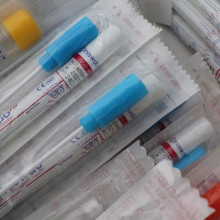
23:41 - Mailbox: Why do COVID tests need a nasal swab?
Mailbox: Why do COVID tests need a nasal swab?
Chris Smith, University of Cambridge
James has been in touch to ask: Why does the COVID lateral flow test require using a rather unpleasant throat or nasal swab ? Why won't spitting saliva into the buffered solution work in the test strips? Chris Smith has the answer...
Chris - Yeah people have likened having these nose and throat swabs to having a brain biopsy. The answer is - reproducibility. Saliva is, in certain cases, a very good measure and marker of infection. If you have something that grows in your nose, in your throat, where saliva washes around, you can use saliva to get the genetic information and sometimes the organism itself or its antigens, the things it makes when it grows, and test for them. But it's difficult and inconsistent. And when people have done studies on coronaviruses, they found that because of the other stuff which can be present in saliva and because people are all different, the areas that they get the saliva from, the volume of saliva they produce and so on, it makes it very hard to produce a test which is consistent and reliable. Whereas a throat swab and a nose swab combined do tend to produce a more reliable, consistent sample, which is therefore easier to test. So at the moment, it's down to practicality and reliability, but watch this space because in the long term we all know spitting into a tube is a lot more attractive than doing a brain biopsy.

How to build a radio
Dave Ansell, Sciansell
To kick off our adventures in radio, Adam Murphy set out to build one, with the help of demo maestro Dave Ansell...
Adam - Radio is everywhere. And in a pandemic, people are finding renewed comfort in the little wireless box. The equipment is simple and easy to get a hold of. And you can indulge in the radio while doing a myriad of other things. Radio waves, which carry the signal are electromagnetic waves, just like light or x-rays, only there are a lot longer. Where light has a wavelength in the billionths of a metre, long radio waves can be kilometres long. Given the ease, you can get a hold of a radio, I thought it should be relatively straightforward to put them together, myself but... Oh, this is so many turns so much copper this is taking so long.No, just stay! Ow, copper gets hot when you heat it Murphy. So I decided to get some help from Dave Ansell. The first bit of the instructions were to wrap a load of copper wire around a tube. So what's that all about?
Dave - So it's doing two things. The first one is it's acting as an aerial. Radio waves are electromagnetic waves, which means they produce electric and magnetic vibrations in space. And there's little magnetic fields and if you have a magnetic field through a coil, it will cause a voltage to be produced on that coil. If an electromagnetic wave goes past your coil, it will cause a varying voltage on the coil.
Adam - Any EM wave going past my coil then can induce a little bit of current in it, which through a circuit, you can get a signal which is a radio, but why so many turns, why so many coils,
Dave - There's all sorts of radio waves going past your coil at the same time, but you only want to listen to one of them. That's one at a certain frequency, a certain pitch effectively. And so you want to build a circuit, which is really sensitive to that pitch, but not sensitive to any other. So the way you do that is you build a resonance circuit. So a bit like if you push a swing, it wants to swing at a certain frequency. The circuit will want to have currents going through it at a certain frequency. And you do that with a coil, which behaves a bit like the inertia of the swing. A bit like a mass on the end of the swing and a capacitor, which is a bit like a spring.
Adam - So with the right combination of capacitors, along with my coil, I can shoot into a specific frequency, a specific station. I've got a little tunable capacitor on this, which has a knob that you can turn to change the capacitance and then change the exact frequency or station that you're tuning into. But that's not the end. My little circuit had a lot of other components, but the other key one is called a rectifier. And that has an important job of its own.
Dave - The right. So the radio waves you're picking up are at a much, much higher frequency than the frequencies we use in speech. You could feed those into a loudspeaker, but you wouldn't hear anything because they're millions of cycles per second. Whereas we hear in thousands of cycles per second. And so you end up with a wiggly line that gets bigger and smaller and bigger and smaller at an audio frequency.
Adam -So one of the things the rectifier does is taken a that's too high in frequency, too high in pitch for you to be able to hear and essentially averages out by just looking at the changes in the amplitude or the loudness, which is in a frequency you can hear, but it's not done yet.
Dave - You can put that into a loudspeaker. You can't hear anything because it averages to zero. So to be able to detect it, you've got to cut away the bottom half of the waves. So you put it through, effectively, a diode so you see the top half of the wave. And then when that's averaged out by the loudspeaker, it will turn into a sound wave at a frequency we can hear
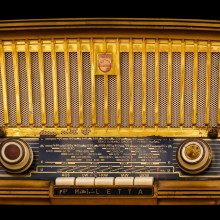
The history of radio
Richard Noakes, University of Exeter
How did inventors stumble on the concept of radio in the first place? Adam Murphy found out from the University of Exeter's Richard Noakes...
Richard - The most important aspect of this is Maxwell's proposal that light is a form of vibration involving electricity and magnetism and their interaction. The paper that Maxwell published showed that measurements of electrical and magnetic phenomena produce the right result or a very good result to the speed of light, to the known speed of light. And so this gave good evidence, not conclusive evidence, that light was actually a form of electromagnetic vibration.
Adam - But the thing about Maxwell's work is it's tricky. Students spend years studying Maxwell's equations and then lie about understanding them. So a lot of other bright sparks put time into expanding Maxwell's work, and one of them was British physicist Oliver Lodge.
Richard - And he's really interested in the possibility that Maxwell's claim that light is an electromagnetic vibration - maybe light can be generated experimentally. And what he does is to produce many versions of lightning flashes in the laboratory using effectively the ancestor of today's capacitors, they're called Leyden jars. His work on this effectively leads him to show that the rapid oscillations of a Leyden jar that's sparking produces kind of waves that flow along wires. But independently of Lodge is a German physicist called Heinrich Hertz. And what he finds is something very similar to what Lodge would find in 1887, which is that there's a kind of wave-like phenomenon between wires connected to Leyden jars. But more interestingly, he's able to find waves flowing outside the wires in free space.
Adam - But Lodge and Hertz weren't really interested in the applications of this. They were interested in the pure science of it all. So they didn't really bother pushing the engineering quite so much. However, Lodge was about to provide some much needed inspiration.
Richard - And it's in 1894 that we see him broaching this topic again. And he does it interestingly in a lecture to memorialise the death of Heinrich Hertz. So Heinrich Hertz died in 1894. Lodge is asked to present a series of lectures on Hertz's work. And in these lectures, he produces a demonstration of a kind of wireless, effectively, telegraphy but on a very small scale. What he does is effectively bring together the kit that he and others have produced to generate electrical waves. And some of the kit that's very well known in conventional wired cable telegraphy. So the kind of Morse key. And what he shows his audience who are stunned by this is that you can send through a lecture theatre coded messages.
Adam - One of the people very interested in this and in that lecture was Italian-Irish physicist Guglielmo Marconi, who had the creativity and the cash to really push the boat out.
Richard - And what Marconi does is effectively to synthesise much of what he reads. And uses that to develop apparatus that he thinks will make wireless stronger and sufficiently stronger for use in forms of signalling and communication. So the very thing that Lodge thought was not going to work out practically. And so from about the mid 1890s through to the early 1900s, Marconi develops this wireless telegraphic system. In 1901 he stages his grandest experiment which is between the West coast of Ireland and the East coast of North America in Canada. So in 1901 what he does is effectively to demonstrate that you can send wireless signals across the Atlantic. He sends one letter, the letter S in Morse coded form, and it causes a sensation.
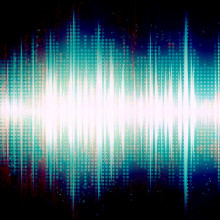
36:22 - Taking to the airwaves: Amateur radio
Taking to the airwaves: Amateur radio
Peter Howell
Marconi’s trans-Atlantic transmission was a massive hit, and it wasn’t long before a radio was something the soldiers in the trenches of WW1 could make with a pencil and a razor blade. And as the costs came down, a hobbyist scene of skilled people also embraced radio and took to the airwaves, using it to communicate around the world. One of the people who does this is Mike Zero Delta Charlie Victor, aka Peter Howell, Who told Chris Smith the next key part of the story, which is how radio signals are produced in the first place and information like speech is added to them...
Peter - Oh, it goes back about 25 years, when my eldest son came home from school and said he wanted a counterbalance to schoolwork, and I'd always been interested in radio. I had a friend who was in the Cambridgeshire District Amateur Radio Club. So we joined, did the courses, took our exams, got our call signs. And the rest, as they say is history.
Chris - But that club can trace its origins back a very long way, can't it? I mean, I mentioned World War One there, and the Cambridge club is about a hundred years old.
Peter - Yes, indeed. We've got documents taking us back to roundabout 1919, 1920. So we're one of the oldest in the country.
Chris - I bet your gear's a bit better than theirs though?
Peter - Uh, yeah, it's improved a bit since the old spark transmitter days.
Chris - Well, who have you spoken to? And do you literally do this in your back bedroom? Is this the sort of hobby that it is?
Peter - I have a shack in an outbuilding, they're always called shacks, and you speak to people all over the world. And I guess the ones that are most memorable, the first one I ever contacted once I got my license was a guy in Devon, and the other, there's two others that stand out. One was around Christmas time with a guy in Finland who was snowed in for three weeks. He's a farmer in the summer and a forester in the winter. And when he's snowed in, he just goes on the radio and had a very long chat. And the second one I remember was talking to a guy in Florida who had a HF radio in his truck, and he just arrived at work in the morning, had sort of five minutes to spare and had a chat with him while he was sitting in the car park at his place of work in Florida. But that sort of, kind of typical, I guess.
Chris - You mentioned that you had to do various exams and certifications in order to be able to do this. What's involved?
Peter - There's three levels of license, if you like. The first one is the foundation license. And that allows you to transmit with about 10 Watts of RF power. And that's enough to get you all over Europe, into Russia. And when the propagation is good, into North America, and when the propagation is really good, worldwide. The next stage is the intermediate license. And that gives you access to 50 Watts of RF power and a few more frequencies. And with an intermediate license, you can then build your own equipment as well. And then the top level one is the full license and you can transmit with up to 400 Watts, build your own equipment and use all the amateur frequencies.
Chris - Can you talk to the space station? Because I'm sure I've spoken to someone before who said that they had booked a time and they were having a chat with people on the international space station.
Peter - Yes, indeed. Some of the astronauts have a radio license and in the two metre band, you can book a slot and talk to them as they come over and it's a very popular demonstration in schools. I've not done it personally, but I know people who have.
Chris - You mentioned the propagation, you said when the propagation is good, what did you mean by that?
Peter - It's linked to the sunspot cycle, which is the 11 year cycle of activity on the Sun, and we're just going into cycle 26. I think it is. And as the number of solar flares build up, and the amount of ultraviolet light coming off the Sun increases, the ionosphere, which is used to refract radio signals round the curvature of the Earth becomes more active, more refractive, and you can get some amazing distances on very minimum amounts of power.
Chris - So you basically bounce your signal from your antenna on the Earth's surface, up onto that notional layer of charged particles out in space, and then it reflects it, and refracts it more accurately, down to another space on the Earth's surface.
Peter - Absolutely right. So it refracts off the ionosphere, and then 70% of the Earth's surface is covered with water, which is a good reflector, bounces off the ocean back up to the ionosphere, and in three or four hops, that's how you get round to Australia.
Chris - Goodness me. Now let's sort of bite the bullet now then, because you have to answer the crucial question, because so far we've learned about making radio waves. We've learned how they did it back in the early days, and set people's eyes popping out of their heads with those demos, which would have been almost like magic, I would think, to the audiences in those lecture theaters, when Lodge and his colleagues were doing this, but when we want to apply voice to radio, like we're talking now, how is that done? Because how do you take just a signal, an electrical signal, and actually make it so that you can apply information to it that can be received.
Peter - I suppose the easiest way is by CW or carrier wave, where you turn your transmitter on and off to generate the CW characters, just like sending Morse with a lamp, which is what it is. Second way is by means of amplitude modulation, where you blend your voice, or you impose your voice pattern onto the radio frequency carrier wave. And it varies the height, or the amplitude of that wave in sympathy with the audio pattern of your voice. So the envelope, it gives you an analog. The varying envelope gives you an analog of your audio signal, and a third way of doing it is by frequency modulation. And here you keep the amplitude constant, but you vary the frequency as an analog of your voice signal. It's a bit like the bellows on an accordion. As the accordion plays, they stretch and contract. So the frequency increases and decreases in sympathy with your voice. So you sort of wobbled the frequency and then you can demodulate it at the far end in your receiver.

43:46 - Aliens on the airwaves
Aliens on the airwaves
Michael Garrett, Jodrell Bank Centre for Astrophysics
It’s not just other humans we’re looking to communicate with. Radio provides some of the most interesting ways to potentially chat with alien life. But how would we go about broadcasting to ET? And how would know if he ever decided to phone home. Michael Garrett, Director of Jodrell Bank Centre for Astrophysics, told Chris Smith about why radio waves can be so useful...
Michael - Well, the nice thing about radio, and in fact one of your speakers just mentioned it - is that you only have to generate very low power waves to be able to communicate across the globe. So if you prepare to actually put a bit more power in your transmitter and you hook it up to, you know, a large antenna, like the Jodrell Bank telescope, then you can actually begin to send these signals, not just around the world, but you can actually send them through space. And indeed over a sort of large fraction of the galaxy. It doesn't cost very much which - as a Scotsman - that's always a good thing!
Chris - I wouldn't dare to say so Michael! But once you've made the signal, if it's in space already, does that mean it's going to propagate indefinitely? Because there's nothing - unless there's a star or some other entity in the way it's just going to go on forever until we pick it up.
Michael - Exactly. Yeah. And radio is really good at that. As you go up to higher frequencies, even when you go into the near infrared and the optical, and even when you get to x-rays, then you get absorption by dust. So anything that's in the path of the electromagnetic signal will get absorbed. But radio would just go through everything. And that's one of the reasons we use it so prolifically here, you know, with wifi, for example, or mobile phones, is that radio waves can travel through windows. They can travel round corners, even go through walls etc.
Chris - Is that what you're listening out for then? You're looking for radio waves originating from off-planet that might have some intelligence behind them?
Michael - Yeah. I mean, that's one of the things that we are interested in doing. The nice thing about a signal that's produced by technology - so a radio signal - is that it's really easy to see the difference between that kind of signal and a natural signal that's maybe being produced by a star or, or a planet or a galaxy. The technology usually produces very narrow band signals and you shift them in their amplitude or in their frequency, or you modulate them or you pulse them in some way. So it's really easy to be able to distinguish those from all the natural radiation that you see. And that's what we're looking for. We're looking for those signatures of technology, when we're looking at radio waves coming from space.
Chris - Isn't an inherent problem with this the scale that we're talking about, when one considers how big the universe is, how big just our own neck of the cosmic woods is. You know, our own galaxy is a hundred thousand light years across isn't it. So if there are aliens out there, then the signals that are traveling at the speed of light will have had to have been traveling to us for us to detect them for a really long time. So are they going to have to be really, really very advanced, way more advanced than we are, for example, in order to have made those signals to give them time to get to us?
Michael - They almost certainly are more advanced than we are. We've only been a sort of technical civilisation for say the last hundred years, if you define that as being when we started to use radio waves back in the time of Marconi. So we've only been doing that for about 120 years, and yes, the scale is a problem. The Milky Way is really, really big. And actually by comparison, the speed of the light is actually very, very slow. And then the other question is you may have many, many technical civilisations, but if they're only around for, you know, for maybe a few hundred years. Or they're only using radio for example for a few hundred years. Even if they're around for 10,000 years, again, it's the scale that gets you because 10,000 years is like a tiny amount of time compared to the age of the Milky way. So you could have civilisations, many of them just coming and going, but they never overlapped in time or in space.
Chris - Indeed, you're sort of sticking a pin in the bubble of "is there life out there" with these sorts of sentiments, aren't you? But as Jill Tarter from NASA once said to me, it's too cheap not to do this sort of project and go looking, isn't it? Have we actually ever picked up anything that might be aliens though?
Michael - I don't think so. There's been a few interesting signals recently actually reported in December. There's a very interesting signal. But it looks as though that's going to be sort of local radio frequency interference, now that the data have been properly analysed. So I don't think we've really had a good example of a signal. But as you say, you know, we can do all sorts of sort of normal astronomy. And in parallel to the astronomy, we can siphon off the signals and we can be looking also for that technological signature that we think we would find with a radio wave that's produced by technology. So we can do our standard astronomy, but at the same time, we can siphon off the data and think about this question. Because for me, I don't think there's a more important question out there than, "are we alone?" Are there other intelligent civilisations out there like us? So I think it's really a cheap way of answering a really important question.
Chris - And what constitutes to you, intelligent life or evidence of intelligent life? Are we sort of looking for the alien equivalent of The Naked Scientists radio programme? Is that what you're looking for?
Michael - Well, it could be that yeah, but it could be all sorts of things. For example, it could be radar systems that perhaps other civilisations are using for their aircraft or for tracking missiles. So it doesn't have to be sort of radio shows per se. We are using radio for all sorts of different types of things. We use them in our mobile systems. We use them in wifi. You know, we're completely surrounded here by radio waves and those radio waves are actually moving off planet. We have the Star Link system that's going to provide wifi from orbit. We have spacecraft that are moving out into the solar system and beyond the solar system. So sort of that radio halo and all that radio activity, we might expect to find that with another technical civilisation. We certainly want to look for that.
Chris - If you were pushed to give an answer to this next question, how likely do you think it is in the next 50 years that we're going to find evidence of alien communications?
Michael - Yeah, I think we've never been in a better position to do it. We are now doing systematic surveys with the best possible equipment. And that's been funded through the breakthrough listen programme that Yuri Milner and Julia Milner have been funding. So we are really doing proper surveys now. I don't know about 50 years, but I wouldn't be surprised if something turns up in the next 10 years, and I think it's definitely worth a couple of quid.

51:50 - QotW: Why are electrons never between orbitals?
QotW: Why are electrons never between orbitals?
Phil Sansom got the answer from Ankita Anirban...
Mejnun - I have learned at school that when an electron excites it jumps to another orbital around the nucleus.
Phil - Remember, electrons are tiny particles, and they move in patterns called ‘orbitals’.
Mejnun - If an electron jumps an orbital you would expect that at that moment it can be found between the two orbitals. My teacher told me that this is never the case. I can not wrap my head around it. Does the particle just disappear in one orbital and appear in the other? Is this instant, is the particle in the other orbital the same? Can you please help me to understand this?
Phil - Mejnun, don’t worry, you came to the right place. Here’s physicist Ankita Anirban...
Ankita - Hi Mejnun!
Phil - She's here to answer what happens when electrons jump to a new orbital.
Ankita - From what you’ve said, it seems to me like you’re imagining orbitals as concentric rings around the nucleus. This is a useful model, but all models are just approximations. And you’ve found the fatal flaw of this model! As soon as you ask - is the electron sometimes between orbitals, there is no good answer. A more accurate way of understanding electrons is through quantum mechanics.
Quantum mechanics is a theory that explains how particles like electrons work, and it's all about probabilities - so when we say an electron is in a certain orbital, it just means that it is quite likely to be in that general area. And if we excite the electron, it just means that the likelihood of finding it in the outer orbital increases. So rather than thinking of an electron physically jumping between orbitals, you can imagine the chances of finding an electron in a given orbital changing.
This might seem quite abstract, but according to quantum mechanics, an electron isn’t actually a tiny billiard ball, hopping between orbitals. A better way of thinking about it is more like a little fuzz of mass and energy that is very hard to pin down. But again, this is still just a model which also has limitations.
Phil - Here’s another comparison, from our forum: chiralSPO says to think of the electron as a wasp. It can be calm, or it can be angry. There is nothing in between, and it can instantly go from one to the other or back. Again, just a metaphor for something extremely complicated!
Ankita - Even though I’m a physicist who deals with electrons daily, trying to actually imagine an electron has sent me down a philosophical rabbit hole!
Phil - Thanks to Ankita for diving in for us. Meanwhile our next question comes from listener Ellie, has been pointing, and clicking, and then wondering...
Ellie - How do ZIP files work on my computer?





Comments
Add a comment